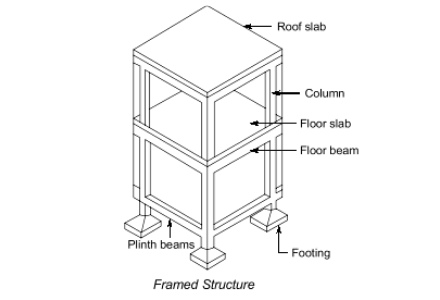Table of Contents
Load Bearing Structure Vs Framed Structure
There are two ways of building houses: the load bearing structure and the RCC framed structure systems.
In this article, we will know the differences between load-bearing structures and framed structures, so let’s begin.
RCC frame structure is also called column beam structure, whereas load-bearing structure is also known as wall bearing structure; it is one of the earliest forms of construction.
Load transfer
The Loads are transferred from a slab to beams, beams to columns, lower columns, and finally to the foundation in the RCC frame structure.
Load-bearing structures don’t have concrete structural members like beams and columns. In this structure, all Loads are carried by the wall and conveyed to the foundation through the masonry walls.
Flexibility in planning and design
In the case of RCC Frame structure, walls don’t carry any load; hence the position of walls can be changed whenever necessary. Therefore there is greater flexibility in planning and design.
But in the case of a load-bearing structure, walls carry the total loads of the structure; hence, it is challenging to change the walls’ position after the construction. Therefore there is no flexibility in planning and design.
Room Dimension
RCC Frame structure gives the flexibility to change rooms sizes, but in the case of a load-bearing system, it doesn’t allow a change in room dimensions.
Thickness of wall
In the case of the RCC Frame structure, the thickness of walls remains the same with an increase in height.
But in the case of a load-bearing system, the thickness of the walls increases with an increase in height.
Carpet Area
In the case of RCC, Frame structure walls are slimmer; therefore, more carpet area is possible to use. But in the case of a load-bearing structure, walls are thicker; thus, less floor area is available for use.
Length of Wall
In the case of RCC Frame structures, there is no limitation on the length of the wall at a stretch. But in load-bearing structures, there is a limitation to constructing a long wall at a stretch.
Earthquake resistance
In the case of the RCC Frame structure, resistance to earthquakes is better. But in the case of Load-bearing systems, resistance to earthquakes is poor.

Construction
The construction process of the frame structure is simple, whereas the construction process of the load-bearing structure is cumbersome.
Speed of construction
Speed of construction for RCC frame structures is more, whereas the speed of construction for load-bearing structures is slow and time-consuming.
Walls Construction
In the RCC frame structure, walls are built after the frame construction, but in load-bearing structures, columns and beams are not in the load-bearing system. Therefore walls are built firstly.
Span
Large spans are achievable in the RCC Frame structure, but large spans are not permissible in a load-bearing structure.
Height
In the case of RCC Frame structure, there is no restriction on height, but in the case of a load-bearing system, height is limited, and it is suitable for up to 2 floors.
Cantilever Member
In the case of RCC Frame structure, cantilever elements can be easily given. But in the case of a load-bearing structure, the inclusion of cantilever elements is challenging and allowed for a short span only.

Additional enclosure
Rcc frame doesn’t offer additional enclosure to water, fire, sound and heat and infill walls are required to provide them.
In comparison, a load-bearing structure offers other enclosures for water, fire, sound and heat.
Soil Conditions
Rcc frame structure can be constructed at any soil that is soft soil, black cotton soil, reclaimed soil etc.
But load-bearing structures can be built on hard strata only.
Material Requirement
Less material is required to construct the RCC frame structure, while more material is required to construct the load-bearing structure.
Cement and Steel Quantity
RCC frame structures consume more cement and steel, while Load-bearing structures consume less cement and steel.
Labour Requirements
For the construction of the RCC frame structure, fewer labours are required than the load-bearing structure. Also, skilled labourers are needed for these constructions.
Whereas for the construction of a load-bearing structure, more numbers of labours are required. Both skilled and unskilled labourers can construct this type of structure.
Excavation
Excavation required for the construction of RCC frame structure is less while Excavation needed for the load-bearing structure is more.
Foundation cost
There is no such increase in cost in the RCC Frame structure with an increase in foundation depth.
Whereas foundation cost of load-bearing structure is higher than RCC frame structure in the case depth of foundation rises beyond the limit, say 1.2 to 1.5 meters.
Life
In the case of RCC, Frame structure life is reduced if not done correctly. But in the case of a load-bearing structure, life is less affected by the technique of work.
Use
RCC frame structure is a primarily used form of construction, whereas load-bearing structure is rarely used.
Cost
Rcc frame structure is economical for multi-storey building whereas Load-bearing structures are only economical for less than three floors.
Final Words
The load bearing structural practice is an early way of construction. The framed structural design comprises framed structures of columns and beams that give a high resistance to lateral forces and are more adaptable compared with the load-bearing structural system.
Thanks!
Also, Read
Difference Between Singly and Doubly Reinforced Beam
Difference Between Beam and Column
Difference Between H Beam and I Beam
Difference Between Tension and Compression